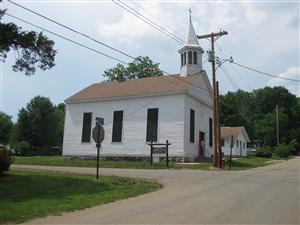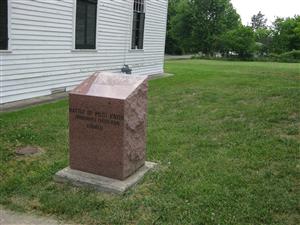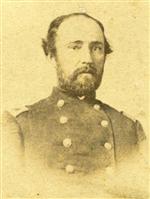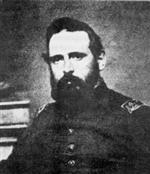Historical Marker: Immanuel Lutheran Church
Tour Stop

 Directions: The Immanuel Lutheran Church Historical Marker [ Waypoint = N37 37.583 W90 38.469 ] is located near the corner of Pine and Zeigler Streets in Pilot Knob, Missouri 63663.
Directions: The Immanuel Lutheran Church Historical Marker [ Waypoint = N37 37.583 W90 38.469 ] is located near the corner of Pine and Zeigler Streets in Pilot Knob, Missouri 63663.
- From the Arcadia Valley Elks Lodge parking lot, turn left (north) onto McCune Street.
- Take the first right onto Walnut Street.
- Go one block and turn left (north) onto Zeigler Street.
- Go three blocks to Pine Street.
- The church is located at the corner of Pine and Zeigler Streets.
- The marker is located on the north side of the church.
Description: The text on the historical marker:
Battle of Pilot Knob
Immanuel Lutheran Church
September 27, 1864
1:00 P.M. – 2:30 P.M.
The Immanuel Lutheran Church was built in 1861 on land deeded to the congregation by the Pilot Knob Mining Co. The church served as a Union hospital during the Battle of Pilot Knob and telegrams found in the building after the battle indicate that it may have been temporarily used as a Union headquarters.
Part of Company F, Fiftieth Missouri Volunteer Infantry, James W. Nations recalled the night of September 27th. [127]
"Night came on, all firing ceased and everything seemed as still as death. The contrast between the silence and the turmoil of the day just passed was so great as to be almost painful. We now had time for serious reflection. Dead men were at hand; almost at my feet was a large mass of coagulated blood, doubtless from a brave gunner. Everybody and everything, it seemed to me, exhibited an aspect of sadness and melancholy,—a reaction from the excitement of the day."
 Colonel Thomas C. Fletcher, 47th Missouri Infantry, described the scene outside of Fort Davidson in the late afternoon of September 27, 1864. [128]
Colonel Thomas C. Fletcher, 47th Missouri Infantry, described the scene outside of Fort Davidson in the late afternoon of September 27, 1864. [128]
"When the final desperate charge had been fully repulsed, the last ray of the setting sun had faded from the mountain top and the evening shadows were beginning to fall in the valley. The firing ceased; not a shot was heard; the silence was broken only by the groans of the wounded who lay everywhere on the field. The enemy was scattered in the gullies, ravines, and behind logs,—in every place of concealment,—waiting the coming of darkness to cover their retreat."
Dr. Seymour D. Carpenter was the Federal surgeon in charge of caring for the wounded. Colonel Thomas C. Fletcher, 47th Missouri Infantry, recalled what actions were taken to care for the wounded. [129]
"Night came on, Surgeon Carpenter organized his corps of assistants, among whom was Dr. James R. McCormick, and we proceeded to care as best we could for the wounded; both our own and the Confederates who were left on the field near the fort. The dead were left where they fell."
 Many buildings in Pilot Knob were used as hospitals following the battle. Immanuel Lutheran Church may well have been the hospital referred to by Lieutenant David Murphy. Murphy, whom Ewing had put in command of the Federal artillery, remembered that the leader of the African-Americans who fought along side of the Federals had been seriously wounded during the day's fighting. [130]
Many buildings in Pilot Knob were used as hospitals following the battle. Immanuel Lutheran Church may well have been the hospital referred to by Lieutenant David Murphy. Murphy, whom Ewing had put in command of the Federal artillery, remembered that the leader of the African-Americans who fought along side of the Federals had been seriously wounded during the day's fighting. [130]
" 'Captain Jim,' as we called the leader of the colored contingent in the fort was stretched upon his back near the sally-port. Observing this I spoke to him, urging him to prepare for a retreat as we had accomplished all that was to be done. He replied: 'Major, I'm done for; there will be no retreat for me. I'm shot through my groin.' … I told him that he should not die … and without further delay I walked across the plain to the town of Pilot Knob, where was located the hospital in charge of Dr. Seymour D. Carpenter, U. S. V. I told him of the disability of 'Captain Jim,' and I was furnished with a stretcher and a man to assist and direct his removal from the fort to the hospital. We lifted 'Jim' gently and carefully. I carried one end of the stretcher to the hospital, and there Dr. Carpenter promised me that he would use all his skill to save the life of the brave negro."
